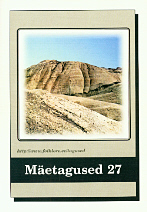Ristipuud maastikul ja usundilises jutupärimuses
Cross-trees on Landscape and in Religious Narratives
Author(s): Marju Torp-KõivupuuSubject(s): Customs / Folklore
Published by: Eesti Kirjandusmuuseum
Summary/Abstract: Cross-trees are an inseparable part of South-Estonian (South-East Estonian, to be more specific) funeral tradition, they have been the research subject of the author for the past fifteen years, and have been discussed in the short papers and popular-scientific articles by the author. Sacred groves and trees belong to the rich Estonian cultural heritage. The article analyses the continuance or fading of the tradition of cross-trees as sacred (grove) trees from an important aspect of mediators of tradition - the possibility of continuance of customs and rituals related to religious convictions in modern natural environment, or, to put it differently, to whom the sacred trees in groves and the sacred stones on fields belong (have belonged) de iure and to whom they belong (have belonged) de facto? Is there a different attitude towards ritual objects of natural origin, which may tentatively divided in two groups, in modern times? (i) Ritual objects (including sacred springs, stones and trees, etc. under nature protection or under protection of national heritage) which reflect the passive and retrospective collective cultural memory, and which are no longer associated with the active lore and ritual behaviour of any social group. (ii) Ritual objects which continue to be associated with the lore and ritual behaviour of a social group (this active connection may have been revived in the course of folklorisation process), and which have a continuous, and active, meaning and relationship for transmitters of folklore. In modern Estonian society the preservation of cultural heritage is concerned with the relationship between lore culture and the preservation of antiquities. Generally speaking, while objects under the protection of national heritage are also objects of cultural heritage, most objects of cultural heritage are not, and very likely will be not, under the protection of national heritage, which comprises only the most valuable part of cultural heritage. (Cultural) heritage, no doubt, is a political choice from the past: it is an evaluative selection, whereas the age of an object or phenomenon is not always relevant in determining its belonging to the core of cultural heritage. Of course, this division into valuable and non-valuable is of dubious nature - should the existing values be abandoned or destroyed to be considered valuable? Next to relics associated with the formation of cultural landscape in present-day Estonia, the objects under the protection of cultural heritage theoretically include buildings and constructions; economic monuments, military monuments, and natural and seminatural monuments, and monuments associated with oral history (8 subcategories, including a separate division for grove sites, grove trees, sacred trees, cross-hills and cross-trees).
Journal: Mäetagused. Hüperajakiri
- Issue Year: 2004
- Issue No: 27
- Page Range: 105-126
- Page Count: 22
- Language: Estonian

